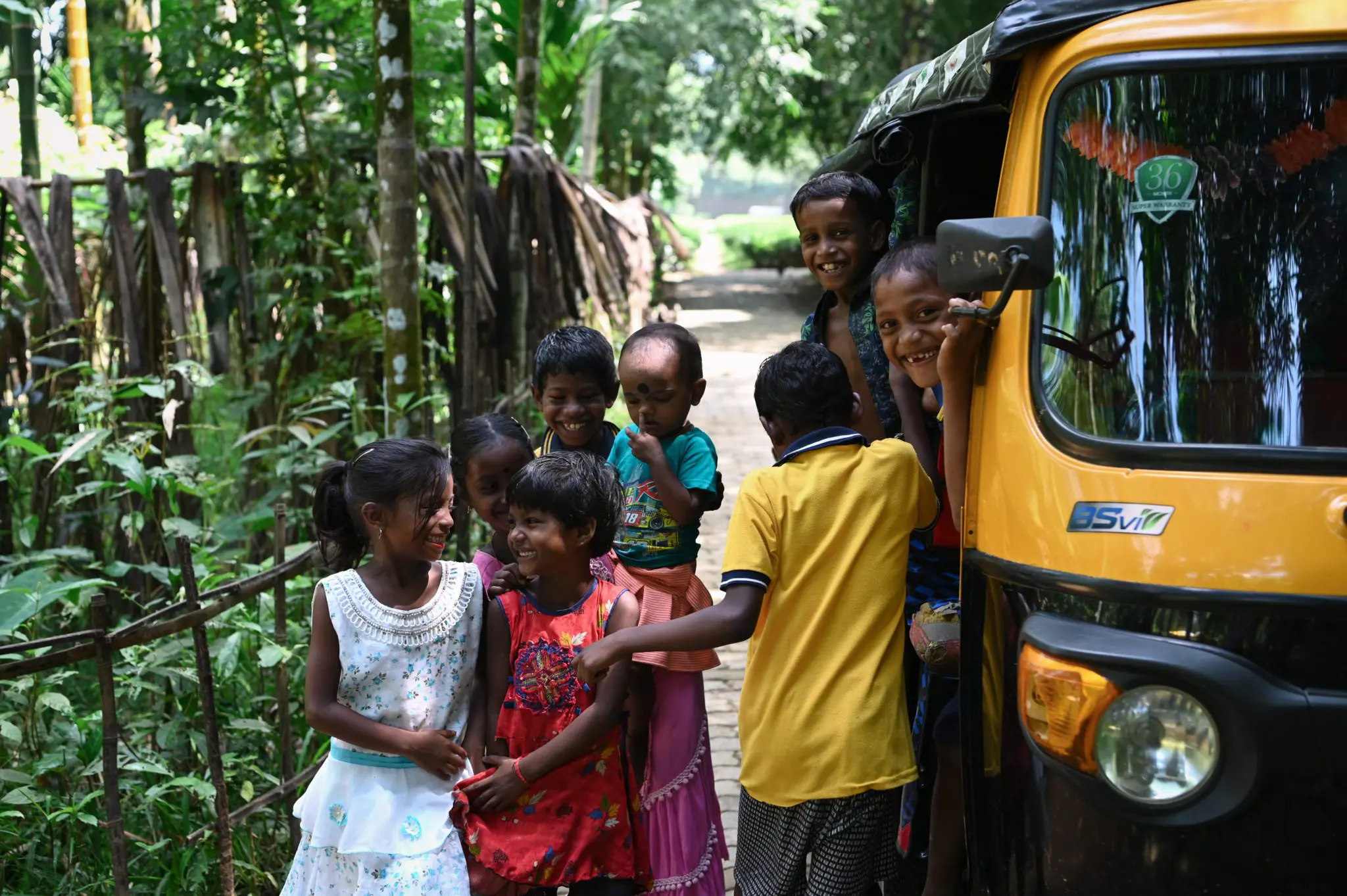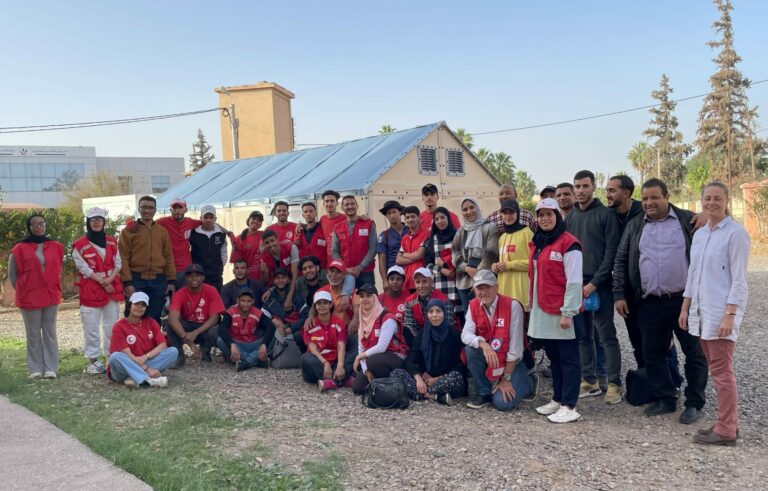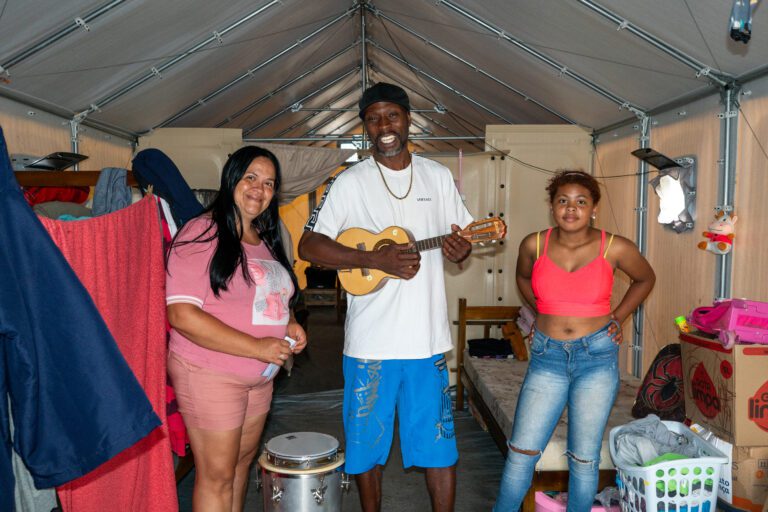In the northeastern corner of India lies the enchanting state of Assam, where lush green hills and dense forests paint a mesmerising backdrop.
This region is one of India’s poorest. More than half of India’s tea is produced in Assam, and many of its citizens earn five dollars daily by harvesting tea leaves in the tea plantations.
Tea plantation workers sift for fresh tea leaves at a plantation farm in Assam.
Photo: Sahiba Chawdahry
Assam faces a recurring and formidable adversary: annual floods. Fueled by the overflow of the state’s massive rivers, these floods claim lives, submerge vast areas, and leave a trail of destruction in their wake. Year after year, residents lose loved ones and rebuild their lives. In 2022, the state of Assam was hit by two major floods, with the second one in July being particularly devastating. It affected 5.4 million people and claimed 200 lives in 32 districts.
Ranjit Nayak, photographed with his wife and 4-year-old twins outside their RHU Structure home in the Kalain region of Assam.
Photo: Sahiba Chawdahry
“My wife and I just grabbed our children and ran”
In many nearby villages, the floodwaters forced residents to leave everything behind and immediately seek refuge on higher ground. One community had to spend 18 days on a bridge near their village. Relief efforts involved helicopter food deliveries and essential supplies, but many community members lacked medicine and other necessities during these weeks. Large swathes of land remained submerged under 4-5 meters of water for many days.
When the waters finally receded enough for people to return, homes had been reduced to ruins, livestock had been lost, and, in some cases, waterlogged houses still stood with half a meter of water inside. In their determination to rebuild, community members used truck tyres and built boats for transportation between elevated village areas.
Rahima Khatun, mother of six and grandmother of 13, photographed outside her home in Assam.
Photo: Sahiba Chawdahry
“We were worried that the younger children would fall into the deeper parts and lined the waterfront with tires to try to keep them safe.”
SEEDS India (Sustainable Environment and Ecological Development Society) responded to the emergency immediately with vital assistance to help people rebuild their homes. They transported 101 RHU Structures to several communities, and some had to be transported on auto-rickshaws, motorcycles, and by foot for the last few kilometres. The structures were erected on clay, sand, and cow dung platforms, covered with tin roofs, and wall panels were weaved using banana leaves, a widely used technique in the region.
Narad Bhomij’s home photographed outside his home in the Kalain region in Assam. A daily-wage labourer, Bhomij is in the process of overcoming trauma of displacement. He was among the first community members to upgrade the RHU Structure frame innovatively providing solutions from weather damage. He lives alone and works consistently to improve and upgrade the shelter frame and help other community members with the same.
Photo: Sahiba Chawdahry
SEEDS India (Sustainable Environment and Ecological Development Society) responded to the emergency immediately with vital assistance to help people rebuild their homes. They transported 101 RHU Structures to several communities, and some had to be transported on auto-rickshaws, motorcycles, and by foot for the last few kilometres. The structures were erected on clay, sand, and cow dung platforms, covered with tin roofs, and wall panels were weaved using banana leaves, a widely used technique in the region.
Jahanara Begum, photographed inside her home in Assam.
Photo: Sahiba Chawdahry
Over a year after the floods, in September 2023, the Better Shelter team’s visit revealed the persevering spirit of these communities. Many families have constructed extensions to their Structure homes using bamboo to create space for kitchens, storage, extra rooms, or even a shelter for their poultry. Some households have solar-generated electricity to power fans and TV sets. Water and sanitation, however, remain pressing due to overflowing wells and contamination concerns. When built last year, the structures were meant to function as temporary homes. But since they have persevered through several storms, the communities have decided to make them their permanent homes.
Gautam Thakur, 25, a SEEDS volunteer, photographed working on community member Narad Bhomij’s home built with the RHU structure in the flood affected area of the Kalain region of Assam.
Photo: Sahiba Chawdahry
While talking to community leaders in one of the villages, one thing is clear: in the face of these challenges, shelter is no longer a pressing concern. The sense of community is striking: neighbours support one another, and children freely roam between houses, welcome everywhere. A close-knit community ensures that every individual is cared for.
Gautam shares a heartwarming testament to the bonds formed between his team and the communities they serve: an invitation to a wedding in one of the villages.
Local community members photographed in Kalain’s region of Assam in September, 2023.
Photo: Sahiba Chawdahry




